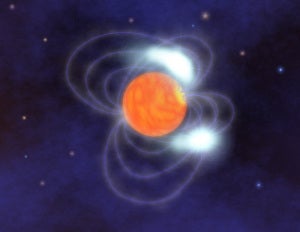By means of the high-speed photometer OPTIMA of the Max Planck Institute for Extraterrestrial Physics (MPE), an unexpected new sub-category of astronomical objects has been detected by a team of MPE scientists might have detected. It appears to be a magnetar with bursts in the visible part of the spectrum, in contrast to the X-ray and gamma flashes that are considered to be characteristic for magnetars.
Alexander Stefanescu received notice that NASA’s Swift satellite detected a brief outburst of high-energy radiation. After observing the location of this outburst, they quickly discovered they had not observed a normal gamma-ray burst (GRB). Instead of the slow decay in brightness usually expected along with occasional short episodes of re-brightening, the scientists observed sudden bright flashes. The observations grew stranger still when the activity hadn’t ceased the next night, but had in fact become stronger, not ceasing completely for several nights.
Examining the radiation emitted during an X-ray outburst, they found out that a part of it had been absorbed by hydrogen gas on the way from the object to Earth. After mapping the gas masses along the line of sight it became clear that the object was likely situated within our own galaxy. This meant it could not have been a normal GRB, because those usually do not happen so close in our neighborhood, but in distant galaxies.
The breakthrough was achieved when the scientists put the special characteristics of OPTIMA to good use. This high-speed photometer built by MPE is the only instrument worldwide combining high time resolution with triggering on unexpected events. The system’s detectors record the arrival time of each photon to an accuracy of 4 millionths of a second. This enables the scientists to reconstruct in detail how the brightness of an object changes.
Detection of individual photons is common practice in the high-energy regime, but OPTIMA is one of the few devices capable of doing this in the optical spectrum. The fast and strong variability of the object’s brightness, observable only with high time resolution, was instrumental in ruling out the initial hypothesis that this was a GRB.
The unknown object was determined to be about a tenth the size of the Sun — but at the same time almost a hundred times as bright. Assuming normal thermal radiation as it is emitted e.g. by the Sun, extraordinarily high temperatures would be necessary to explain this kind of luminosity.
“So high, in fact, that it’s hard to see how an object of this size can heat up and then immediately cool down so quickly,” explains Stefanescu. “So the only possible conclusion was that we had observed a non-thermal process: light that is not produced by heat as in a light-bulb or in a candle, but by particles in a magnetic field.”
The observation of short, bright flashes, continuing over several days, reminded the scientists of non-thermal high-energy outbursts of so called Soft Gamma Repeaters (SGRs). The shape, the statistical distribution of the individual flashes’ brightness, and a slight indication of periodic emission were quite to characteristics of SGRs. Therefore the scientists conjectured that the same type of object is involved as in SGRs: a magnetar. Magnetars are a special type of neutron stars with an extraordinarily powerful magnetic field.
Neutron stars form in a supernova, when a massive star collapses. If a newborn neutron star rotates very quickly, its strong magnetic field can be amplified by a factor of 1,000, the resulting field
reaching 100 Gigatesla — more than a billion times stronger than the strongest fields generated in labs on Earth. The field is so strong that atoms in its vicinity are distorted into thin needles. Credit cards would be erased even from the distance of the Moon.
Changes in the configuration of the magnetic field during the first 10,000 years of its existence exert forces of such strength on the magnetar’s crust that it is heated up and can crack. The resulting star-quakes produce those outbursts of high-energy radiation similar to the optical outbursts observed.
But what makes the presumable magnetar emit in the optical instead of in gamma-rays? One possible theory is that highly charged ions are ripped out of the magnetar’s surface and gyrate along the field lines. Because ions are much heavier than electrons, they gyrate a lot slower, emitting electromagnetic radiation of much lower energy.
Most observations of magnetars have taken place in the high-energy range.
“We know 15 other magnetars, but up to now, no optical flashes of these have ever been seen”, says Stefanescu. “Accordingly the main efforts of theoreticians were made in the high-energy regime. That’s why we don’t have an adequate theory against which to compare the observations with OPTIMA.” The next step of the scientists therefore must be to study the consequences magnetar theories predict for optical emission.










